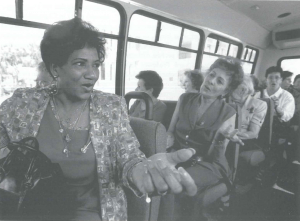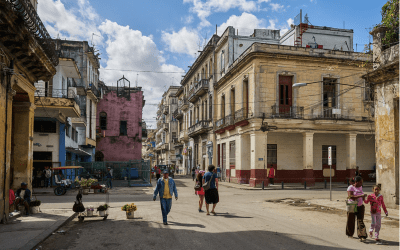Bilingual Aesthetics
Distancing the Monolingual Minority

Bilingual conversations on a Miami bus. Photo by Nuri Vallbona.
How does one language interrupt another? How do different languages simultaneously inhabit the same space? How do language games threaten monolinguism? More than a hundred students, professors, and community members gathered to identify and investigate the “bilingual question” that affects the United States today. Harvard Professor of Romance Languages and Literatures Doris Sommer, the main conference organizer, said that the one-day conference entitled “Bilingual Aesthetics” sought to pose the “bilingual question” to fields that have somehow remained indifferent to it, including politics, aesthetics, psychoanalysis, humor, and linguistics. The conference aimed to investigate pertinent work where politics and poetics meet-where languages, especially Spanish and English, grapple with one another.
The first panel of the December 4 conference joined three academics from three different disciplines: Ana Celia Zentella (Hunter College), Robert Schwartzwald (University of Massachusetts, Amherst), and Yunte Huang (Harvard University). Zentella, author of Growing Up Bilingual, studies the role of bilingualism in New York City’s Puerto Rican community. Her book addresses the complex nature of growing up speaking English and Spanish, and, consequently, Spanglish. The title of her presentation, “José, Can You See,” a bilingual play on words, alludes to the U.S. national anthem, but replacing “Oh say,” with “José.” In other words, the Spanish interrupts the English in this context. Schwartzwald, a scholar of Canadian francophone literature, titled his presentation, “Devenir-mineur/ Devenir minoritaire?” looking at the relationship between language and identity. Professor Huang, a leader in Chinese-American literary criticism here at Harvard, focused on the idea of “Pidginizing Chinese” through a bilingual context. The three presentations varied in examples and specific research. However, all of the presentations addressed the relationship between bilingualism and identity.
The panelists precisely analyzed the manner in which bilingual games–the use of two tongues–marks a difference in the construction of identity for minority communities in the United States. The conference, sponsored by Harvard University’s Ethnic Studies Committee and The Americas Seminar at the Humanities Center, showed that a unique premise intertwined the distinct cases that each scholar addressed: the bilingual game, albeit social or esthetical, serves to mark a difference. This difference establishes a distance between the bilingual–the players of the bilingual game–and the monolingual majority.
Jose Luis Falconi, a graduate student in the Harvard Romance Languages and Literatures Department, remarked that the esthetic and social strategies of understanding bilingualism are difficult to differentiate. In both cases the strategies search to demarcate a distinct pertinence from the monolingual majority. Falconi added, ” Bilingualism transforms itself into a strategy with which one can establish a difference in identity that does not seek to blend into one single majority identity, but attempts to maintain itself disassociated and dissonant and hopes to be accepted in spite of its reluctance to being totally absorbed.”
The second panel discussion, moderated by Doris Sommer, included several experts in the study of bilingualism: Gustavo Pérez-Firmat (Columbia University), Reda Bensmaia (Brown University), and Arnaldo Cruz Malav (Fordham University). The relationship between aesthetics and politics evolved as an important theme in this particular discussion. Bensmaia discussed the strategy of translation as a strategy in aesthetics that acknowledges the tensions between languages. Translation serves as a “space of production.” Cruz Malave also touched upon this theme of translation, but focused more on the idea of mobilizing power relations in contextually specific social spaces through translational strategies. According to Cruz Malave, Puerto Rican cultural practices have “deterritorialized colonialism” by not accepting obligatory or hegemonic routes to achieve assimilation, but by creating “counter hegemonic routes.” Speaking Spanish or Spanglish represents one of these routes. Thus, assimilation becomes less conventional and more diverse, like bilingualism.
Joaquin Torres, a grad student in the Romance Languages and Lits Dept, observed, “Gustavo Pérez Firmat gaves us an exceptional close-reading with a decidedly poetic register of a Calvert Casey short story, Reda Bensmaia filtered Maghreb’s dense political situation through a highly nuanced theoretical frame, and Arnaldo Cruz Malave produced an originally articulated panoramic view of US Puerto Rican literature.”
The last panel of the evening followed a brief wine break, in which people were able to talk to one another about the day’s profuse dialogue. Visiting Harvard Professor Juan Bruce-Novoa, a scholar in the field of Chicano/Latino history and literature, moderated this subsequent panel that included Tino Villanueva (Boston University), Ramon Saldivar (Stanford University), and Ilan Stavans (Amherst College) as speakers.
Professor Villanueva read bilingual English-Spanish poems to the audience and analyzed how certain Spanish words and concepts are untranslatable in English. For instance, there is no direct translation in English for Spanish diminutives. In Spanish, according to Villanueva, there exist the “dimunativo gustativo,” which means the tasteful or attractive diminutive, but not in English. Villanueva also explained how bilingual writing, like Alurista’s poems, does not constitute a modernist or postmodernist way of writing. Rather bilingual writing is simply a “bisensitive” writing that maintains the tone and connotation of each word in its most natural or home-like language.
Saldivar also discussed bilingual poetry, but related poetry to the Mexican tradition of corridos, folk ballads that narrate a story. Saldivar explained how one particular corrido influenced Americo Paredes’ poetry written in English. Thus, the Spanish ballad affects the English language in Paredes’ poems. Stavans’ anecdotal presentation recounted how one Chicano student at Amherst College entered Professor Stavans’ office speaking Spanglish to him. Stavans, a Jewish-Mexican who grew up speaking Yiddish and Spanish, confessed he was shocked to hear a student speak Spanglish to him without hesitation or deliberateness. Stavans explained how he could not help but envy the young man’s courage and freedom to use his “private” language in the context of a public and academic setting in such a natural manner.
The conference concluded with a poetry reading featured all well-recognized poets in Chican@/Latin@ literature and, more revealingly, in the field of bilingual poetic expression: Tino Villanueva, Evangelina Vigil-Pinon, and Giannina Braschi. After so much talk of bilingualism, it made sense to hear from those that capture the bilingual esthetic in their own art. Chicana poet Evangelina Vigil-Pinon, author of Thirty an’ Seen A Lot, not only read some of her most intriguing bilingual poems, but also serenaded the audience with her guitar strokes and wonderful singing. Giannina Braschi, a celebrated member of the Nuyorican Poets group, read an excerpt from her book Yo-Yo Boing! Her ability to fuse English, Spanish, and Spanglish in her writing and presentation of her text is an awing and invaluable experience, students said. Braschi did not take time to breathe, or so it appeared, in her reading, pronouncing every tone and utterance with poetic and political thrust. Villanueva, the last poet of the evening, read a number of bilingual poems that mainly intimated something personal about his childhood growing up in Southern Texas, speaking Spanish at home and incorporating English and even Spanglish into his life. The poems manipulated English, Spanish, and Spanglish, demonstrating the relationship between biculturalism and bilingualism as well.
Salvador Espinosa, a Harvard College sophomore, noted that “for [him] as an undergraduate, [the conference] was a great opportunity to learn about the exciting fields of study that graduate students and professors throughout the United States are conducting in relation to bilingualism.”
Espinosa also expressed that “it was great to hear the three different poets recite their own bilingual poetry.”
“Bilingual Esthetics” served to highlight the provocations that bilingualism produce today in the United States. Doris Sommer, the main event organizer, explains today’s bilingualism as a period and space in which “Spanish is teasing English out of its univocal complacency, while elsewhere in the Americas, indigenous languages are changing the sound of Spanish in public spheres.” Languages are therefore being stretched by unconventional practices towards borders that expand artistic expression and challenge the narrowness of a single tradition. As Doris Sommer intimated to me one day, “idiota” is what the dignified Adam Bede called the single-language speaker in ninth century England. In the midst of the conference, this description still sustained a provocative ring.
Monica M. Ramirez is currently a junior at Harvard College, concentrating in Literature. Monica comes from a bilingual and bicultural community in Southeast Los Angeles and hopes to write a thesis next year addressing bilingualism in Chica@/Latin@ literature.
Related Articles
Forum on U.S. Hispanics in Madrid
The Trans-Atlantic Project, an academic initiative to study the cultural interactions between Europe, the U.S. and Latin America has been invited by Casa de América, Madrid, to present a …
Cuba Study Tour
Waiting at José Marti International Airport for the first Harvard students to arrive for January’s DRCLAS Cuba Study Tour, my companion, a theater critic at Casa de las Américas, commented to me …
The Soulfulness of Black and Brown Folk
And so, by faithful chance, the negro folksong – the rhythmic cry of the slave – stands to-day not simply as the sole American music, but as the most beautiful expression of human experience …




